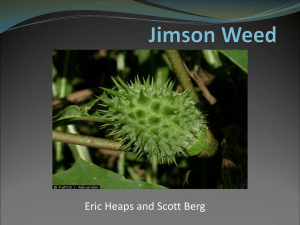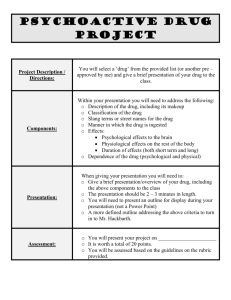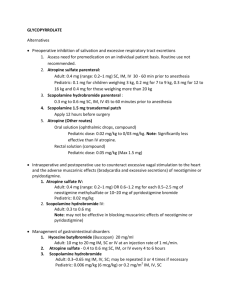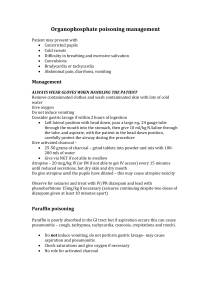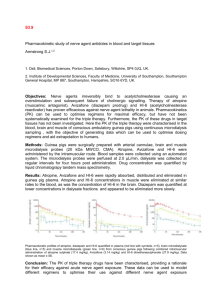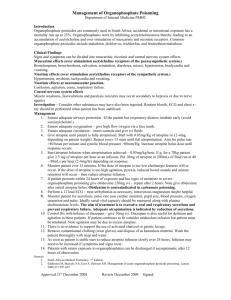Document 10465484
advertisement
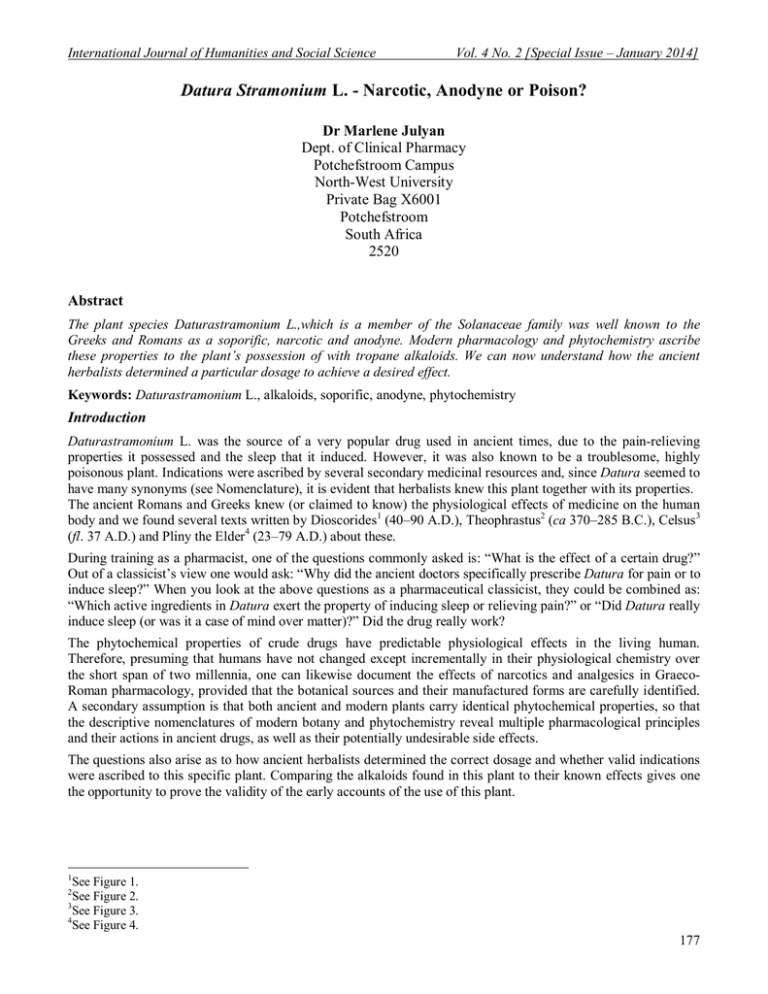
International Journal of Humanities and Social Science Vol. 4 No. 2 [Special Issue – January 2014] Datura Stramonium L. - Narcotic, Anodyne or Poison? Dr Marlene Julyan Dept. of Clinical Pharmacy Potchefstroom Campus North-West University Private Bag X6001 Potchefstroom South Africa 2520 Abstract The plant species Daturastramonium L.,which is a member of the Solanaceae family was well known to the Greeks and Romans as a soporific, narcotic and anodyne. Modern pharmacology and phytochemistry ascribe these properties to the plant’s possession of with tropane alkaloids. We can now understand how the ancient herbalists determined a particular dosage to achieve a desired effect. Keywords: Daturastramonium L., alkaloids, soporific, anodyne, phytochemistry Introduction Daturastramonium L. was the source of a very popular drug used in ancient times, due to the pain-relieving properties it possessed and the sleep that it induced. However, it was also known to be a troublesome, highly poisonous plant. Indications were ascribed by several secondary medicinal resources and, since Datura seemed to have many synonyms (see Nomenclature), it is evident that herbalists knew this plant together with its properties. The ancient Romans and Greeks knew (or claimed to know) the physiological effects of medicine on the human body and we found several texts written by Dioscorides1 (40–90 A.D.), Theophrastus2 (ca 370–285 B.C.), Celsus 3 (fl. 37 A.D.) and Pliny the Elder4 (23–79 A.D.) about these. During training as a pharmacist, one of the questions commonly asked is: “What is the effect of a certain drug?” Out of a classicist’s view one would ask: “Why did the ancient doctors specifically prescribe Datura for pain or to induce sleep?” When you look at the above questions as a pharmaceutical classicist, they could be combined as: “Which active ingredients in Datura exert the property of inducing sleep or relieving pain?” or “Did Datura really induce sleep (or was it a case of mind over matter)?” Did the drug really work? The phytochemical properties of crude drugs have predictable physiological effects in the living human. Therefore, presuming that humans have not changed except incrementally in their physiological chemistry over the short span of two millennia, one can likewise document the effects of narcotics and analgesics in GraecoRoman pharmacology, provided that the botanical sources and their manufactured forms are carefully identified. A secondary assumption is that both ancient and modern plants carry identical phytochemical properties, so that the descriptive nomenclatures of modern botany and phytochemistry reveal multiple pharmacological principles and their actions in ancient drugs, as well as their potentially undesirable side effects. The questions also arise as to how ancient herbalists determined the correct dosage and whether valid indications were ascribed to this specific plant. Comparing the alkaloids found in this plant to their known effects gives one the opportunity to prove the validity of the early accounts of the use of this plant. 1 See Figure 1. See Figure 2. 3 See Figure 3. 4 See Figure 4. 2 177 The Special Issue on Contemporary Research in Behavioral and Social Science © Center for Promoting Ideas, USA Ancient use of Datura Datura as soporific, narcotic and local anodyne Dioscorides, as well as Theophrastus, (Theop. H.P. 9.11.5) concluded that Datura was used as hypnotikon (sleepinducer) (Diosc. 4.74). Theophrastus likewise indicates that when a draught was prepared of bruised bark soaked in wine, it induced sleep. TheDe Medicina of Cornelius Celsus records that Datura was not only used to induce sleep, but also as a topical anodyne for local pain relief. It also has an astringent effect due to the presence of tannin (5.20.3). Pliny the Elder, however, wrote the following on Datura: "Quin et alterum genus quod halicacabonvocantsoporiferumestatqueetiamopiovelocius ad mortem, ab aliismorion, ab aliis moly appelatum" (H.N. 21.180). "There is besides another kind, with the name of haliccacabos, which is soporific, and kills quicker even than opium, by some called morion and by others moly.” The mental effect of Datura in the process of inducing sleep When Dioscorides describes the property (dynamis) of the strychnosmanikos root, he remarks that a drachma5of the substance taken with wine engenders not unpleasant mental images, but if two drachmai6are quaffed, you could lose your wits for as long as three days (4.75). He warns that too large a quantity will have a fatal effect. Theophrastus writes that the plant called strykhnos induced sleep, caused madness7,8 and upset the mental powers. Celsus also refers to the use of Datura to soothe the insane. He writes that solarium, which the Greeks call stryknos,is one of the plants which simultaneously "repress" (reprimunt) and "cool" (refrigerant) (2.33.2). He writes: “Utilesetiam in quibuscumqueviribusduaeherbaesunt, solanum et muralis, sisimul ex utraquesucoexpresso caput impletur. Cum febrisremisit, frictioneutemdumest, parciustamen in iis, qionimishilares quam in iis, qui nimistristessunt” (3.18.9). "Whatever the patient's strength, the two herbs, bitter-sweet (i.e. Datura) and pellitory, are beneficial, if the head is wetted with the juice expressed from both simultaneously. When the fever has remitted, recourse should be had to rubbing, more sparingly however, in those who are overly sad". The following quote from Pliny's HistoriaeNaturalis proves that he obtained the same information about Datura's effects from his sources: "Drachmae enimpondere...imaginesqueconspicuasobversaridemonstrantes, duplicatumhuncmodumlegitimaminsaniamfacere, quidquidveroadiciaturponderirepraesentari mortem" (H.N. 21.178). "... a dose of one drachma9... [the users are] speaking of hallucinations and realistic visions; that a double dose causes downright insanity; any repeated ingestion moreover to the dose bringing instant death". Nomenclature The ancients referred to Datura with different names. Reasons for that could include the era (B.C. or A.D.), the culture (Latin or Greek) or even traditional folklore. The ancient Greek physician, PedaniusDioscorides, lists a number of names for what they called thorn apple (Daturastramonium L.), suggesting that he and his sources were very familiar with the plant. He writes: "The thorn apple which some called perseion, others perisson, others anydron, others pentodryon, others enory, others thryon, and others orthogyion..."(4.73.1). The more common name was doryknion,10 a term preferred by 5 3.411g. 6.822g. 7 Theop.H.P. 9.11.6. 8 Theop.H.P. 9.19.1. 9 3.411 g. 10 Δόρν = spear. 6 178 International Journal of Humanities and Social Science Vol. 4 No. 2 [Special Issue – January 2014] Dioscorides to Crateuas'11two alternatives, namely Haliccacibon or calleas (Diosc. 4.74). Ancient warriors used the juice of the plant which they called doryknion to dip their spear points in before battle. The poison was freely available since the plant grows everywhere and the ancients believed that the soldiers instantly killed whomever they injured with these spears. Those who censured the drug less severely gave it the name manikon,i.e. "maddening"; those who, from evil motives, tried to keep its nature secret called it erythron, i.e. "red"; it was also called neuras,i.e. "exciting the nerves", or perisson, which can mean either (a) "superfluous" or (b) "extraordinary" (Jones 1951:287). Today Daturastramonium L. is also known asJimsonweed, Devil's apple, Devil's trumpet, Thorn apple, Belladonna, Metelnut, Deadly nightshade and Solanum, and in Afrikaans as Stinkblaar, Olieblaar, Olieboom, Olieneut and Steekblaar. The seeds are also often referred to as malpitte (i.e. crazy seeds) in Afrikaans. Dosage The following translation from Theophrastus' text gives us an indication of the amount of Datura used to obtain the desired effect: "The kind12 which produces madness (which some call thryoron and some peritton) has a white hollow root about a cubit13 long. Of this three twentieths of an ounce14 in weight is given, if the patient is to become merely sportive and to think himself a fine fellow; twice this dose15 if he is to go mad outright and have delusions; thrice the dose,16 if he is to be permanently insane; (and then they say that the juice of centaury is mixed with it); four times the dose17 is given, if the man is to be killed (H.P. 9.11.6). Dioscorides gives a warning, saying that if too much of the doryknion is ingested, it kills (4.74). With his warning about strychnosmanikos, he is more specific: four drachmai18 of the substance will prove fatal (Diosc. 4.75). Theophrastus agrees with Dioscorides about the quantity which would prove fatal (H.P. 7.15.4). Antidote Dioscorides prescribes an antidote (antipharmakon) for strychnosmanikos. He writes that large quantities of hydromel19 should be taken to induce vomiting (4.75). Must was regarded as particularly efficacious against doryknion when it had been used on the spear points of warriors.20 According to Aristotle, a draught of woman's milk is a very effective antidote to doryknion,21and Pliny similarly mentions raw milk22 and ass’s milk.23Pliny also adds sea-urchins, a decoction of sea-crab,24 oysters25 or myax26,27 to the list of cures. Modern science of Datura DaturastramoniumL. and DaturatatulaL. are two different species found in South Africa but, according to Watt et al. (1962:946), there is much evidence that these annual weeds are variations of the same species, as it is often impossible to distinguish the one from the other.28 11 Chief physician of Mithridates VI of Pontus (120-63 B.C.). See Plin. H.N. 21.177 -179, Diosc. 4.73. 13 30 cm. 14 4.3 g. 15 8.6 g. 16 12.9 g. 17 17.2 g. 18 13.664 g. 19 Hydromel is a mixture of honey and water. 20 Plin.H.N. 23.30. 21 Plin.H.N. 28.74. 22 Plin.H.N. 28.129. 23 Plin.H.N. 28.158. 24 Plin.H.N. 32.58. 25 Plin.H.N. 32.59. 26 MyrtusaxillarisSw. 27 PlinH.N. 32.95. 28 For the physical appearance of the DaturaStramonium L. plant, see Figure 5. 12 179 The Special Issue on Contemporary Research in Behavioral and Social Science © Center for Promoting Ideas, USA The main difference is the flowers. Hutchings (1996:280) refers to D. tatulaL. as a synonym for D. stramonium L. Datura is a naturalised plant and is not indigenous to South Africa (Germishuizenet al. 2003:914) but is found in gardens, along roadsides and other waste or cultivated land. According to Arnoldet al. (2002:129),Datura is administered only to humans. Phytochemistry Modern phytochemistry reveals that, except for the stimulant cocaine, all the significant tropane alkaloids are found in the potato family, the Solanaceae. Liquid chromatography, photodiode array and mass spectrometry (Steenkampet al. 2004:31-39) were also used to conclude that the alkaloids present in Datura include scopolamine29 and atropine30 (not less than 0.3% of total alkaloid content) present in varying concentrations in all the different parts of the plant, which are classified as anticholinergics (Sweetman 2002:463). These constituents are present in all parts of the plant, in variable concentrations (dry leaves contain 0.2-0.65% of tropane alkaloids, of which atropine makes up not more than 70% and scopolamine 20%) (Van Wyket al. 2004:123). This implies that all parts of the plant can induce delirium and hallucinations (Hoffmann 2003:122). Evans writes that at the time of collection, atropine and scopolamine are usually present in the proportion of about two parts atropine to one part scopolamine, but in young plants scopolamine is the predominant alkaloid. The larger stems contain little alkaloid (not more that 3%), and the seeds contain about 0.2% of mydriatic alkaloids. The roots have a higher proportion of alkaloids than the aerial parts (Evans 2002:343), but the leaves contain about 0.5% of alkaloids. Pharmacokinetics Hyoscyamine (atropine) lacks CNS (central nervous system) activity because of poor penetration through the blood-brain barrier into the brain (Brown et al. 1996:150), caused by the water solubility of the plant. Tropane alkaloids are usually fat soluble and are readily absorbed through the skin (Lewis et al. 1977:419). Pharmacology The complete ester of tropine and tropic acid is essential for the antimuscarinic action of atropine, since neither the free acid nor the base exhibits significant antimuscarinic activity (Brown et al. 1996:149). Atropine and scopolamine paralyses the parasympathetic nervous system (antispasmodic effects) by blocking the action of effector cells of the acetylcholine released at nerve endings. It also stimulates the central nervous system (Dreisbachet al. 1987:346). Atropine competitively inhibits the action of acetylcholine (ACh) at the acetylcholine receptor in the nerve synapse, thereby preventing the parasympathetic nervous system from sending out electrical nerve impulses. The parasympathetic nervous system regulates non-volitional/subconscious activities (such as sweating, breathing, and heart rate) and when it is prevented from sending out signals, the heartbeat and breathing become extremely irregular. It is known that atropine has anticholinergic activity-for example it blocks constriction of the iris with resistant, mydriasis results (Brown et al. 1996:150). Scopolamine lacks the central stimulant action of atropine; its sedative properties make it effective in the control of motion sickness. Scopolamine hydrobromide is employed in preoperative medication, usually with papaveretum, some 30-60 minutes before the induction of anesthesia (Evans 2002:344). a. Other uses Atropine and scopolamine differsquantitively in antimuscarinic actions because of the difference in permeability. Scopolamine has prominent central effects at low specific doses because of its ability to cross the blood-brainbarrier, while atropine lacks this ability (Brown et al. 1996:150). 29 30 The molecular structure of scopolamine can be seen in Figure 6. The molecular structure of atropine can be seen in Figure 7. 180 International Journal of Humanities and Social Science Vol. 4 No. 2 [Special Issue – January 2014] This drug is also successfully used in conditions that include neuralgia,31 chronic rheumatism, lumbago,32 myalgia,33 pleurisy,34 pulmonary tuberculosis and mastitis 35 (Lee 2007:79). The daturine alkaloids also cause cycloplegia,36 and it is used in combination with morphine in obstetrics to induce "twilight sleep". It is also used in criminology as the so-called "truth-drug" (Avery et al. 1959:51), because it induces disturbed consciousness and at the same time causes loss of short term memory (twilight sleep) (Martin 2002:712). In Europe the seeds and plant extracts were used in the treatment of mania, epilepsy, melancholy, rheumatism, convulsions and madness (Lewis et al. 1977:167). Daturacauses dryness of the mouth; this property can be used to control excessive salivation, for example in Parkinson's disease (Williamson 2003:418). Atropine is used today in a sulphate form, in eye drops or intravenously, to stimulate the central nervous system and inhibit the nerve endings of the secretory glands secretory glands' nerve endings (Rossiter 2012:569). Scopolamine (synonymnhyoscine), in butylbromide form, is used mainly for its antispasmodic action of the gastrointestinal, biliary and genitourinary tracts. Oral absorption is poor and duration of action brief. CNS effects include drowsiness and fatigue. A preparation containing the crude form of the purified active ingredient in South African pharmacopoeia is Buscopan® (Rossiter2012:46). Administration of the drug Because of their anticholinergic action the leaves are burnt and the smoke inhaled to alleviate bronchospasms (Robbers et al. 1999:112). Duke adds (1985:161) that the leaves may be smoked in a pipe, alone, or with other herbs like belladonna and tobacco. Mexican Indians take the decoction, made from the leaves, to relieve parturition pains (Duke 1985:161). Pulverised seeds in fermented drinks or infusion of leaves and twigs lead to intoxication and hallucinations (Lewiset al. 1977:402). Macerated seeds in alcohol are used as an ointment for rheumatism, neuralgia, haemorrhoids and abscesses as a homeopathic cure (Duke 1985:161). Dosage It is calculated chemically that the maximum daily dose of atropine may not exceed 2 mg. The prepared Stramonium BP consists of a finely powdered drug, adjusted to an alkaloid content of 0.23-0.27% (Evans 2002:343). In eye drops, the concentration may not exceed 3%, while 0.5% is the minimum effective concentration. When patches are used which are pasted behind the ear (against motionsickness), the active ingredient is approximately 1.5% scopolamine (Van Wyket al. 2004:123). Toxicity Van Wyk writes that 100mg of Datura constitutes a lethal dose for humans (Van Wyket al. 2002:86).Human poisoning by Datura is due mostly to the seed (commonly known as "malpitte" in Afrikaans) (Van Wyket al. 2002:86; Steenkampet al. 2004:31–39). The chief constituents of the leaves, unripe capsules and especially the seeds are scopolamine and largely L-atropine. Even small amounts of leaves or seeds can be fatal (Lewiset al. 1977:54), although leave-poisoning is much less common (Wattet al. 1963:942). Accidental inclusion of the seed in foodstuffs has caused poisoning (Wattet al. 1963:949) and it has happened that children sucked the nectar from the flowers. The seed, which has been broken or powdered, produces more rapid effects. The seed contains less active principals than the leaf, stem and root (Wattet al. 1963:950). The leaves also cause poisoning when they are accidentally collected as wild spinach (in the Tswana tradition known as "marogo"). The marogo (Tswana) dry leaf in South Africa has yielded up to 0.36% of alkaloids, of which the chief component is atropine (Wattet al. 1963:952). Hutchings (1996:280) reports that there was a tragic episode of poisoning among the Zulu people after they had cooked the leaves of Datura to eat as vegetables. 31 A severe burning or stabbing pain often following the course of a nerve (Martin 2002:464). Pain in the lumbar or loin region, of any cause or description (Martin 2002:400). 33 Pain in the muscles (Martin 2002:448). 34 Inflammation of the lung-pleura, often due to pneumonia (Martin 2002:542). 35 Inflammation of the breast, usually caused by bacterial infection via damaged nipples (Martin 2002:414). 36 Paralysis of the ciliary muscles of accommodation in the eyes (Martin 2002:172). 32 181 The Special Issue on Contemporary Research in Behavioral and Social Science © Center for Promoting Ideas, USA a. Effects of Datura poisoning High doses of atropine lead to restlessness, irritability, disorientation, hallucinations and delirium. Scopolamine in therapeutic doses causes central nervous system depression, manifested as drowsiness, amnesia, fatigue, and a dreamless sleep (Brown et al. 1996:150). Symptoms of belladonna poisoning are the same as those for atropine, and include dilated pupils, tachycardia, hallucinations, blurred vision, loss of balance, a feeling of flight, staggering, a sense of suffocation, paleness followed by a red rash, flushing, husky voice, extremely dry throat, constipation, urinary retention, and confusion. The skin can completely dry out and slough off. Fatal cases present with a rapid pulse that turns feeble (Lee 2007:80). Due to the extremely high risk of overdosing, many deaths and hospitalizations are reported from recreational use. The effects of Daturahave been described as a living dream: the patient loses and regains consciousness and converses with imaginary or absent people. The effects can last for days. Very few other substances produce the same effects as tropane alkaloids, i.e. very vivid hallucinations and an inability to distinguish between real and unreal stimuli (Hoffmann 2003:122). Current antidote Tincture of belladonna contains 30 mg of atropine alkaloids per 100mL. The fatal dose of atropine (or scopolamine) in children may be as low as 10mg (Dreisbachet al. 1987:345). In case of poisoning it is necessary to delay absorption by the administration of activated charcoal. Physostigmine or pilocarpine is used intravenously as antidote (Dreisbach et al. 1987:37). Conclusion Although the ancients used Datura as a soporific and local anodyne, they could not make a definite statement why the plant would exert the specific effects discussed in this article. This became possible with the development of the modern technology and scientific understanding. Although our only sources on ancient medicine are theavailable texts of ancient medicine and treatment, ithas become possible to compare the records of the ancient effects (merely what the people experienced) with the modern analytical results. We are able to explain in terms of the characteristics of the alkaloids why atropine would not produce anesthesia but why both atropine and scopolamine have a paralyzing effect on the nervous system. We can conclude that atropine is the culprit why Datura cannot be classified as a narcotic drug. Due to the scopolamine content (and the combination of scopolamine with atropine), the employment ofDatura as a soporific and local anodyne in antiquity is valid and thus why the treatment would be successful. Although the ancient Romans and Greeks lived close to nature, they probably observed the physiological effects that this plant had specifically on the patients they treated.Thus, to answer the question of how the ancient medical practitioners determined specific dosages, and after comparing the lethal dosages prescribed by them, the most obvious answer is trial and error. Calculations indicate clearly that the ancients prescribed certain dosages that were almost 4 times greater than that which modern pharmacology considers being safe. We can thus conclude that the constitution of people was either much stronger in ancient times than in the 21st century, or that the translators were not accurate when converting the amounts mentioned in the ancient texts. Even though Datura was (more regularly) used for generations (and remains in use) as anodyne and even soporific, it is of great importance to remember that it is a poison and the distinct possibility of accidental poisoning is real. It not only relieved pain during ancient surgery, but also killed people. Tolerances develop easily with regular use of this plant product, an indication that this is not such a harmless hallucinogenic plant as one may think.The side effects which have been mentioned forDatura, explain its sombre reputation and its association with the devil (it is also called Devil's apple). It is not an innocent herb at all, even when taken in moderate doses. 182 International Journal of Humanities and Social Science Vol. 4 No. 2 [Special Issue – January 2014] References Arnold, T H, Prentice, C A, Snyman, EE, Tomalin, M, Ottas-Bircher, C&Rouch, N R 2002. Medicinal and magical plants of Southern Africa: an annotated checklist. Pretoria: National Botanical Institute. Avery, A G, Satina, S &Rietsema, J 1959.The genus Datura. New York: Ronald Press Co. Beck, L Y 2005.PedaniusDioscorides of Anazarbus.De MateriaMedica.Hildesheim: Olms-Weidemann. Brown, J H & Taylor, P 1996.Muscarinic receptor agonists and antagonists. In Hardman, J G &Limbird L E (eds),Goodman and Gillman: The pharmacological basis of therapeutics9th ed., 141-160.New York: McGraw-Hill. Dreisbach, RH & Robertson, W O 1987.Handbook of poisoning12th ed.Connecticut: Prentice-Hall. Duke, JA 1985. Handbook of medicinal herbs. Boca Florida: CRC Press. Einarson, B & Link, G K K 1976.Theophrastus. De CausisPlantarum. Cambridge, Mass: Harvard University Press. Evans, W C 2002.Trease and Evans Pharmacognosy. London: W.B. Saunders. Germishuizen, G & Meyer, NL2003.Plants of Southern Africa: an annotated checklist. Pretoria: National Botanical Institute. Hoffmann, D 2003.Medical herbalism-The science and practice of herbal medicine. Rochester, Vermont: Healing Arts Press. Hutchings, A 1996. Zulu Medicinal plants. Pietermaritzburg: University of Natal Press. Jones, W H S 1951.Pliny Natural History. Cambridge, Mass.: Harvard University Press. Lee, M R 2008. SolanaceaeIV: Atropa belladonna, Deadly nightshade. J R Coll Physicians Edinb. 37, 77-84. Lewis, WH & Elvin-Lewis, MPF 1977.Medical botany: Plants effecting man's health. New York: John Wiley and Sons. Martin, EA 2002. Oxford Concise Medical dictionary. 6th ed. London: Oxford University Press. Robbers, JE & Tyler, VE 1999.Tyler's herbs of choice: The therapeutic use of phytomedicinals. New York: The Haworth Herbal Press. Rossiter, D 2012.South African Medicines Formulary 10th ed. (SAMF). Cape Town: Health and Medical Publishing Group of the South African Medical Association. Scarborough, J 2009.Thomapple in Graeco-Roman pharmacology.Classical Philology104, 1-14. Spencer, W G 1935. Celsus. De Medicina. London: Heinemann. Steenkamp, P A, Harding, N M, Van Heerden, F R & Van Wyk B E 2004. Fatal Datura poisoning: identification of atropine and scopolamine by high performance liquid chromatography / photodiode array / mass spectrometry. Forensic Science International 145, 31-39. Sweetman, S C 2002.Martindale: The complete drug reference. 33rd ed. London: Pharmaceutical Press. Watt, JM& Breyer-Brandwijk, MG 1962.The medicinal and poisonous plants of Southern and Eastern Africa. Edinburgh: E. & S. Livingstone Ltd. Van Wyk, BE, Van Heerden, F & Van Oudtshoorn, B 2002.Poisonous plants of South Africa. Pretoria: Briza Publications. Van Wyk, BE & Wink, M 2004.Medicinal plants of the world. Pretoria: Briza Publications. Williamson, E M 2003.Potter's Herbal Encyclopedia: The authoritative reference work on plants with a known medical use. London: The C.W. Daniel Company Limited. Figure 1: Theophrastus of Eresus http://classicpersuasion.org/pw/diogenes/dltheophrastus.htm 183 The Special Issue on Contemporary Research in Behavioral and Social Science © Center for Promoting Ideas, USA Figure 2:PedaniusDioscorides of Anazarbus http://www.greekmedicine.net/whos_who/Dioscorides.html Figure 3:AulusCornelius Celsus http://www.philosopedia.org/ Figure 4: Pliny the Elder http://en.wikipedia.org/wiki/Pliny_the_Elder 184 International Journal of Humanities and Social Science Vol. 4 No. 2 [Special Issue – January 2014] Figure 5: TheDaturaStramonium L.plant as it is known today http://www.123rf.com/photo_13770844_thorn-apple-or-jimson-weed-or-datura-stramonium-vintage-engravingold-engraved-illustration-of-thorn.html Figure 6: The molecularstructure of scopolamine http://www.lookchem.com/NewSell/memberproductdetail.aspx?spid=2050775 Figure 7: The molecular structure of atropine http://www.lookchem.com/NewSell/memberproductdetail.aspx?spid=1749028 185
